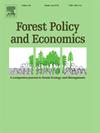利用妇女的传统生态知识,通过光声解决半干旱的加纳牛油果树毛虫(Cirina butyrospermi)的侵扰
IF 3.8
2区 农林科学
Q1 ECONOMICS
引用次数: 0
摘要
气候变化正在加剧世界范围内病虫害的出现。尽管非洲各地越来越多的研究集中在主食和一些乔木作物上,但学术界对撒哈拉以南非洲乳木果树毛虫季节性侵扰所构成的威胁的关注有限。在加纳北部,乳木果树(Vitellaria paradoxa)为许多妇女及其家庭提供了主要的收入和生计选择。利用女权主义政治生态学,本定性研究采用了photovoice来考察妇女的生活经历,包括她们对加纳北部乳木果毛虫侵扰的观察、信仰和适应策略。视觉和主题分析的结果显示,挑战和机遇并存。这些妇女认为牛油果毛虫的侵扰越来越难以预测,季节性的变化和强度归因于气候模式的变化。他们认识到毛虫是一种害虫,它会广泛地使乳木果树落叶,同时也提供高蛋白的食物来源。研究结果揭示了关于毛虫影响的相互矛盾的观点,一些妇女认为落叶通过促进新生长来增加牛油果的产量,而另一些人则认为它与产量下降有关,注意到虫害后树木变弱。这项研究强调了乳木果种植区妇女的多样化生态知识,这对于建立抵御气候变化的能力和建立可持续的乳木果生产系统至关重要。它为在气候变化不断升级的背景下进一步探索牛油果毛虫侵扰的复杂性奠定了基础。这项研究的结果表明,以社区为基础的方法可能是一种有效的气候知情虫害管理战略。本文章由计算机程序翻译,如有差异,请以英文原文为准。

Harnessing women's traditional ecological knowledge through photovoice to address shea tree caterpillar (Cirina butyrospermi) infestation in semi-arid Ghana
Climate change is intensifying the emergence of pests and diseases worldwide. Despite mounting studies across Africa focusing on staple and some tree crops, there is limited scholarly attention on the threats posed by the seasonal infestation of the shea tree caterpillar across the sub-Saharan African shea-growing belt. In northern Ghana, the shea tree (Vitellaria paradoxa) provides the primary income and livelihood alternative for many women and their households. Drawing on feminist political ecology, this qualitative study employed photovoice to examine women's lived experiences, encompassing their observations, beliefs, and adaptive strategies related to shea caterpillar infestations in northern Ghana. Results from the visual and thematic analysis show a mix of both challenges and opportunities. The women perceive shea caterpillar infestations as increasingly unpredictable, with seasonal shifts and intensity attributed to changing climate patterns. They recognize caterpillars as pests that extensively defoliate shea trees while also providing a high-protein food source. The findings reveal conflicting perspectives on the effect of the caterpillar, with some women believing that defoliation increases shea yields by promoting new growth, while others associate it with yield declines, noting weakened trees post-infestation. This research highlights the diverse ecological knowledge of women in shea-growing regions, which is essential for building resilience against climate change and establishing sustainable shea production systems. It sets the stage for further exploration of the complexities of shea caterpillar infestations in the context of escalating climate change. Findings from this study indicate that a community-based approach could be an effective climate-informed strategy for pest management.
求助全文
通过发布文献求助,成功后即可免费获取论文全文。
去求助
来源期刊

Forest Policy and Economics
农林科学-林学
CiteScore
9.00
自引率
7.50%
发文量
148
审稿时长
21.9 weeks
期刊介绍:
Forest Policy and Economics is a leading scientific journal that publishes peer-reviewed policy and economics research relating to forests, forested landscapes, forest-related industries, and other forest-relevant land uses. It also welcomes contributions from other social sciences and humanities perspectives that make clear theoretical, conceptual and methodological contributions to the existing state-of-the-art literature on forests and related land use systems. These disciplines include, but are not limited to, sociology, anthropology, human geography, history, jurisprudence, planning, development studies, and psychology research on forests. Forest Policy and Economics is global in scope and publishes multiple article types of high scientific standard. Acceptance for publication is subject to a double-blind peer-review process.
 求助内容:
求助内容: 应助结果提醒方式:
应助结果提醒方式:


